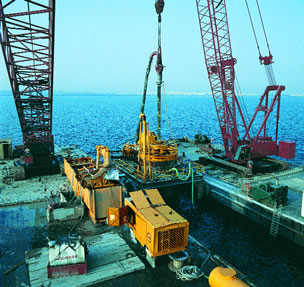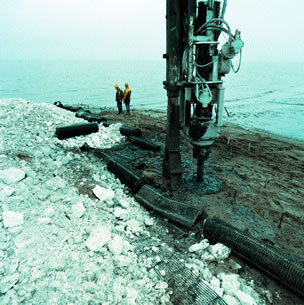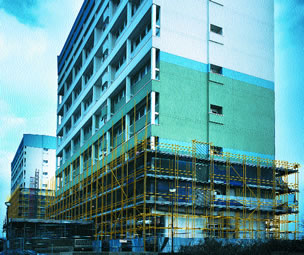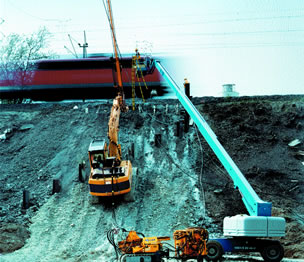| Case studies | ||
 Niagara Falls, North America Problem: In North America, we were called upon to assist in creating a working platform for the extension of the observation tower at the Niagara Falls Visitors’ Center. Solution: Hayward Baker and Catoh combined their specialist skills to install rock anchors in the river gorge wall to support guy wires for a full height scaffolding system around the tower. A crane was used to position the drill rig on the rock wall. |
Foundations
Hayward Baker gave its best-ever performance with record sales, gross margin and operating profit. The results of the foundations operations were excellent in 2001, with sales 31% ahead at £347.8m (2000: £265.3m) and operating profit before amortisation of goodwill of £23.6m (2000: £16.6m), some 42% better than the previous year. This strong growth was largely organic, with all operating units showing sales ahead of last year. North America 2001 was a record year for our North American operations, with operating profit well ahead of the previous year, reflecting the strong underlying fundamentals of our North American businesses. Hayward Baker gave its best-ever performance with record sales, gross margin and operating profit due, in part, to its core strategy of regionalisation throughout North America. Whilst offering global technologies, regionalisation offers clients a local presence, which is considered essential in winning small and medium-sized contracts. In line with this strategy, we opened an office in the San Francisco Bay area in December 2001 to foster interest in the area. Another success factor was the strong growth in several key product markets in the geotechnical construction sector. The construction community continues to adopt our techniques in ever increasing numbers, progressively expanding our market share. Such techniques include minipiling, soil mixing, jet grouting and vibro. Hayward Baker and Case continued to be involved in contracts at port facilities, power stations, mass transit systems, airports and TEA21 infrastructure projects, along with a wide variety of small to medium sized jobs in the private sector. Among the major contracts undertaken during the year was work following the tragic events at the World Trade Center. Shortly after 11 September, Hayward Baker was contacted by New York City’s consulting engineers to discuss possible assistance with underground support throughout the recovery and reconstruction efforts. Within four weeks, Hayward Baker was on site working in joint venture with one of our competitors to provide the expertise and level of resources necessary for the project. Hayward Baker’s work entailed the installation of high capacity tieback anchors through the existing World Trade Center basement walls. The tieback anchors are necessary to support the basement walls against the exterior forces created by soil and groundwater as the debris from the collapsed structure is removed from the basement area. As a result of further work awarded in January 2002, Hayward Baker’s work is likely to continue until late Spring of 2002 when recovery operations should conclude. Another noteworthy project involved vibro work carried out as part of the high profile Pier 400 project at the Port of Los Angeles. The work involved extensive bottom feed vibro in two areas and dynamic compaction in a third. The effect of these ground improvement techniques was to mitigate the risk of damage during seismic events over a large area of reclaimed land originally created by backfilling with dredged sands or silts. This project was successfully completed in difficult soil conditions and within tight deadlines. |
|
| back to top | ||
 Borman Park, North America Problem: In Gary, Indiana, a new water intake system, located one mile offshore, required an intake crib to be connected to a tunnel through the bedrock. Solution: Case Foundation drilled an 11 foot diameter shaft through the lower bedrock and installed a steel liner to connect the tunnel to the intake crib. A drilling platform needed to be anchored to the lake bed, with two barges anchored alongside to support cranes and other equipment. |
Case
Foundation and Case Atlantic returned excellent results, with sales
and operating profit both significantly ahead of the previous year. Case was involved
in several prestigious projects during the year, including the construction
of a large diameter water intake shaft approximately one mile offshore
in Lake Michigan. Among several successful projects in the north-eastern
United States was one for the South Jersey Light Rail System, while
in the mid-west Case installed the caissons for a new convention
centre in Grand Rapids. In Charleston, South Carolina, Case Atlantic
carried out piling work for two bridges and was awarded a significant
contract for a two year project at the Cooper River Bridge, as part
of the TEA21 federal infrastructure budget spend.
|
|
| back to top | ||
 Alter Hof, Germany Problem: One of the oldest buildings in Munich, the former residence of Germany’s Wittelsbacher royal family, needed reconstruction after lying empty for 10 years. The age of the building and a restrictive working area added challenge to the task of strengthening the foundations. Solution: Keller combined jet grouting columns and mini-piles to increase the bearing capacity of the existing foundations. Specially prepared drilling rigs, suitable for confined spaces, installed more than 190 Soilcrete columns and 24 mini-piles without affecting the integrity of the existing structure. |
The
broad spread of our operations and the mix of contracts protected
us from the slowdowns experienced in parts of Europe and the Middle
East. Continental Europe and overseas The European and overseas business achieved a good performance, despite difficult economic conditions in some of our markets. The broad spread of our operations and the mix of contracts protected us from the slowdowns experienced in parts of Europe and the Middle East. Our German operations succeeded in increasing turnover by more than 12% whilst improving margins, thereby returning an encouraging result, in contrast to a 7% downturn in the construction sector. A strong performance was shown by our businesses in Poland and France, which are becoming well established. In France, we introduced piling as a product line to support our ground improvement services. Major contracts in France included one at Nice Airport, where Keller installed vibro stone columns to reduce the risk of liquefaction and increase the earthquake resistance of the proposed main terminal building and car parks. During the year we developed our Spanish business, undertaking four vibro contracts there in the second half of the year. We were involved
in a number of environmental schemes in Continental Europe, including
a major groundwater improvement scheme in Bruck, Austria, requiring
the decontamination of subsoil using horizontal jet grouting; the
rehabilitation of a dam near Krakow in Poland; and, in the Rhein-Ruhr
area of Germany, over 20 contracts for exploration drilling and
cavity grouting of disused mines, to protect the local population
from the collapse of unstable shafts and tunnels. Outside Europe,
the Far East performed well, particularly Malaysia and Singapore.
Keller, with some participation from LCM, is stabilising the soil
beneath the realignment of a railway line in Malaysia, using stone
and lime cement columns. The success of the project, together with
similar joint ventures between LCM and the UK ground engineering
business, demonstrates our good progress in transferring the newly
acquired technology to other regions of the world. Furthermore,
we commenced vibro work at Hong Kong’s Container Terminal 9,
marking a return to Hong Kong, after more than four years’
absence from the city. |
|
| back to top | ||
 Kingston upon Hull, UK. Problem: As part of a land reclamation scheme to extend the Port of Hull, a six metres high bund wall had to be constructed over tidal mud flats. Extremely soft underlying marine clays made the original construction method impractical and an alternative solution was sought. Solution: In its first UK application, Keller offered the recently acquired Swedish dry soil mixing system. The method involves the mixing of cement powder directly into the soil to strengthen the underlying clays and enabled the successful construction of the bund wall. |
Keller
remains the market leader in the UK ground improvement subsector,
which accounts for an increasing proportion of its work. UK The UK ground engineering market was relatively static during the year, with continued overcapacity in the foundations sector. However, Keller remains the market leader in the UK ground improvement subsector, which accounts for an increasing proportion of its work and where recent growth has come largely from an increase in the development of brownfield sites. The ground engineering business had a slow start to the year, due to the very wet weather, which resulted in delayed contract starts. Activity picked up as the year progressed, however, the result was affected by costs associated with remedial works. Significant projects included vibro stone column work at the port of Mostyn in North Wales and contract 320 at the Channel Tunnel Rail Link project, where vibro concrete columns were used to provide a stable working platform, allowing construction of a viaduct. Bored piling contracts included continuing jobs at Canary Wharf and a new hotel complex and associated development at West India Quay. The specialist grouting division benefited from a compaction and void filling grouting job at Reading, where previous mineworkings had threatened to cause severe settlement to local authority housing units. Here, a novel approach combining probe drilling, injection grouting and compaction grouting provided a solution to undermining caused by cavities in the underlying chalk. The specialist grouting division has also been working alongside our Swedish soil mixing contractor, LCM. The application of lime column technology for the first time in the UK is providing a solution to a near intractable problem at Hull docks, where foundations for a bund are being created on very soft marine alluvium in tidal conditions. Through good co-operation across all divisions, the ground engineering business was able to offer packaged solutions, consisting of ground improvement and earthworks. In the current year we hope to accelerate the provision of complete enablement solutions for new and brownfield sites. |
|
| back to top | ||
 Manly Apartments, Australia Problem: A retaining structure was needed to support an adjacent six storey building on one boundary and to provide a water barrier for a two level basement car park. The site, next to the world famous Manly beach, had a permanent high water table. Solution: A 600mm diameter retaining wall was installed to a depth of eight metres below the existing site level. Temporary soil anchors were used to control wall deflections and resist the high surcharge loadings. Franki Atlas piles were installed to provide structural support for the building. |
Franki
operations in Australia and Indonesia enjoyed a significant turnaround
due, in part, to the restructuring carried out in 2000 and to a more
stable business environment in Australia. Australia Franki operations in Australia and Indonesia enjoyed a significant turnaround due, in part, to the restructuring carried out in 2000 and to a more stable business environment in Australia. The Indonesian operation performed particularly well, given the political uncertainty and fragile economy of the region, with activity steady throughout the year in each of its product lines. Major contracts during the year included several major precast projects in the docklands precinct of Melbourne. Franki also entered into a joint venture with Vibropile for the foundations for one of the tallest residential buildings in the world – Grollo’s Eureka Tower in Melbourne. This project, with the most complex foundations we have encountered on a building site in Australia, is nearing successful completion. A common feature of contracts successfully completed during the year was the resolution of major foundation and logistical problems through effective communication and close co-operation with the client. One such job was in the Pilbara region of Western Australia, where BHP Billiton operate a series of major iron ore mines. One of these, at Yandi, is located some 400km from the coastal shipping port of Port Hedland. The Yandi mine load-out facility had to remain operational during upgrading and only limited time windows were available for the work. Franki, together with the client, their consultants and the steel work contractor, devised a cost-effective solution which involved building a structure around the existing tunnel, whilst allowing loading operations to continue. A complex matrix of “what ifs” was drawn up, as no delay to the contract could be tolerated. Standby units of critical plant, such as drilling rigs and concrete batching plants, were required on site. Time was of the essence and the work was completed on time and to budget. |
|
| back to top | ||
 Houston, North America Problem: Increasingly, the commercial construction market in the United States is seeking ways to reduce material and labour costs and to increase design flexibility associated with structural spans, beams and floors in concrete frame, high-rise buildings. Solution: Suncoast’s post-tension systems involve the tensioning of cables which have been pre-placed in the concrete. Compared to traditional reinforcement methods, post-tensioned slabs are faster to install – saving on labour costs, stronger – allowing thinner slabs for the same strength, and allow longer spans – adding to design flexibility. |
Specialist
services Looking ahead, the Suncoast business is well placed to take advantage of growth opportunities. The results for specialist services include the full year for Makers and three months of Suncoast. Operating profit before goodwill amortisation was 32% ahead at £3.7m (2000: £2.8m) on turnover of £74.4m (2000: £47.6m). Suncoast On 1 October 2001, we completed the acquisition of Suncoast – a Houston based market leader in the design, fabrication and distribution of post-tension cable systems to the construction industry. Post-tension cable systems are used to reinforce concrete foundations and structural spans, enhancing their load-bearing capacity by applying a compressive force to the concrete, once set. Post-tension technology has been used in North America since the mid 1960s and has been used increasingly in the residential and commercial construction markets. This trend has been driven by the cost savings in labour and materials and the enhanced design flexibility, compared with more traditional reinforcement methods. Post-tension reinforcement foundation slabs are particularly appropriate to the soil conditions found in Texas, California and Arizona, where Suncoast has developed its principal operations. The market for post-tension reinforcement systems has seen significant growth. Annual growth rates in the use of post-tension systems in the US residential market averaged 26% between 1990 and 2000, compared to only 4% annual growth rates in new house construction over the same period. In 2001, 56% of Suncoast’s sales came from the concrete foundation slabs market, primarily for use in the construction of single family homes. 24% of its business came from the commercial construction sector, relating to the use of concrete structural spans and beams in a wide range of concrete framed structures including hotels, sports stadia and parking garages. Suncoast also offers a rebar design and supply package, either with Suncoast’s post-tension systems, as part of a concrete reinforcement solution, or for use on a stand-alone basis. This complementary product area represented the balance of Suncoast’s sales in 2001. The Suncoast business has traditionally been seasonal, with a relatively quiet final quarter. Since its acquisition, the performance of Suncoast has been as anticipated. With historically low interest rates and a continuing strong level of housing starts in the United States, Suncoast’s first full year’s contribution in 2002 should be in line with our expectations at the time of acquisition. Looking ahead, the Suncoast business is well placed to take advantage of growth opportunities which are expected to come from the continued technology transfer in the concrete foundation slabs market; continued favourable demographics which support new housing demand in Suncoast’s core markets; geographical expansion outside Suncoast’s current core residential markets; increased penetration of post-tension systems in the commercial construction markets; and opportunities for consolidation within a highly fragmented post-tension industry. |
|
| back to top | ||
 John Walsh and Fred Wigg Towers, UK Problem: The external refurbishment of these twin towers, as part of The London Borough of Waltham Forest’s “Safe and Warm Policy”, involved Makers treating concrete deterioration caused by an array of factors, including advancing carbonation, chloride attack and some poor structural detailing. Solution: Systems and materials were selected to offer low maintenance and a 30-year design life. Makers’ “best value” bid offered technically appropriate alternatives for the external wall insulation system and concrete repair solution, together with value engineering of the designs for the roof, rainscreen and replacement windows. |
During
2001, the strategic aim was to consolidate and to strengthen the core
business systems. Makers Over the five years since acquisition, Makers has seen a compound growth in sales of 24%. During 2001, the strategic aim was to consolidate and to strengthen the core business systems. This has created a strong platform from which to exploit the significant growth opportunities emerging across all its sectors. Makers has benefited from a growing number of partnership arrangements, through which it has been able to secure long-term contracts at commercially acceptable rates. Our customers benefit from the reinvestment in training, information technology, supply chain management and customer care services, which together generate improved service delivery. In social housing, Makers has won major contracts on partnering schemes with the London Boroughs of Westminster, Waltham Forest and Camden for the refurbishment of housing stock. Makers’ growing reputation for quality and community care has enabled it recently to enter into a joint venture to deliver reactive maintenance services for part of a social housing complex in London’s Westminster. This marks a first step into a new sphere of business. We believe the strong contracting skills and high customer focus within the business will make this a good strategic move into facilities management. The relationship with BAA has matured and during the year Makers progressed a number of contracts to refurbish car parking facilities at Heathrow and Gatwick Airports. The success of this experience positions the business well to support local authorities and railway companies on similar projects in the future. Makers has traditionally undertaken cladding work on an ad hoc basis. With an increase in demand for this type of construction, two business units were set up during the year to cover the national market. Makers’ track record, skilled workforce and its relationships with materials suppliers mean that it is well placed to benefit from the growth in this sector. A good performance was delivered by the AMS division, which showed improvements in all major business areas and a new business unit was set up during the year to supply services to communications companies upgrading mobile phone networks across the UK. The masonry division had success on a number of key contracts including St Paul’s Cathedral, Norwich Cathedral and Norwich Castle. Wannenwetsch |
|
| back to top | ||
 Eichenberger Curve, Germany Problem: Following reunification of East and West Germany, infrastructure connections needed to be re-established. To reopen and extend the railway connection between Gottingen and Halle, the wall of a dam had to be strengthened to accommodate an underpass, without interrupting the operational railway. Solution: Keller stabilised the wall of the dam, with a 35 degree slope, using fine cement grouting. This required the installation of specialist pipes into the slopes of the dam. A customised drilling rig was designed and built for the inclined working platform. |
We
shall continue to seek acquisition opportunities to broaden our offering
of technical services to world markets. Strategy The performance of the Group in 2001 confirms that our strategy of maintaining global leadership in the core foundations businesses, while expanding our range of specialist services, continues to deliver benefits for the Company, its shareholders and its employees. In further pursuit of this strategy, we shall continue to seek acquisition opportunities to broaden our offering of technical services to world markets. We shall focus our search principally on specialist services businesses within Europe, which offer strong growth prospects. Any such acquisitions will redress the balance between our North American operations, which currently account for some two-thirds of profits, and the rest of the Group. In addition, we will continue to enhance the geographical and technical coverage of our market leading foundations businesses through bolt-on acquisitions, where appropriate. We believe our strategy will continue to enhance value for shareholders. Outlook |
|
| back to top | ||